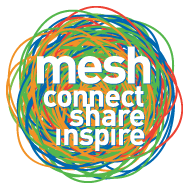|
The Mesh: Why the Future of Business Is Sharing
( her website is http://lisagansky.com/) This was an interesting book in which the author explained the characteristics of what she defines is a mesh business (Lisa Gansky seems to kind of see this as web 3.0); 1. the core offering is something that can be shared, within a community, market, or value chain. 2. Advanced web and mobile data networks are used to track goods and aggregate usage, customer, and product information. 3. The focus is on shareable physical goods, including materials used, which makes local delivery of services and products, and their money, valuable and relevant. 4. Offers, news, and recommendations are transmitted largely through word of mouth, and augmented by social services networks. I view the mesh as a infinitely connected and ever more complicated internet. A mesh describes a type of network that allows any node to link in any direction with any other nodes in the system. Every part is connected to every other part, and they move in tandem. Lisa Gansky believes Mesh businesses profit by streamlining access to physical goods and services. She sees them as easy to start and they leverage current available information infrastructure, and then they employ horizontal business to business services ( Fed Ex, Paypal). Mesh businesses all rely on the basic premise that when information about goods is shared, the value of the goods increases, for the business, for the individual, and for the community. Mesh businesses are well positioned to constantly improve their customers experience by refining the overall experience and give long term savings - think items seldom used, high priced, high insurance ( cars, RV's, tools). Here is Lisa Gansky at a TED conference; [youtube http://www.youtube.com/watch?v=IHBGLHgIWJM?rel=0&w=480&h=390] The authors believes in learn - test - play - engage - repeat, which is a kind of play on the entrepreneur's fire, ready, aim. She believes in the process of producing beta editions and then modify in response Lisa Gansky sees that the challenge is to leverage an infrastructure for real time personalization Mesh businesses are taking what we have learned collectively about what works in the web businesses and they are applying it to the sharing of physical products. Mesh requires durable, flexible, reparable, and sustainable. The era of disposal products is gone. Things need to be built to last, the goal is to create products and then spread the cost of the life of them over several transactions and over many people. The mesh encourages open and agreed upon design standards. http://meshing.it/ - the book web site The Mesh: Why the Future of Business Is Sharing- the book on amazon Cradle to Cradle - all products need to be designed so that they can be reused or reclaimed. I think this will be a major factor in business in the future. 5 vectors make the mesh viable; the current economic crisis has created distrust of companies,the crisis has also made people reconsider what is valuable to them, the climate change is increasing the cost of business, in addition greater populations and urban density favor mesh and information networks have matured. You can create a flash brand that is finely tuned to a particular community at the key time it is needed. Mesh blends well withg other trends in changing to a more niche market. Think the Long Tail by Chris Anderson. Here is the link to Amazon; Long Tail, The, Revised and Updated Edition: Why the Future of Business is Selling Less of More It is no longer critical to think what is next, instead think what is first in people's minds, what is important to them. 5 types of risk due to climate change: regulatory risk physical ( weather) reputation competitive litigious When looking for business opportunities she puts it in a simple and clear way - value unused = waste = food for a startup 7 keys to building trust in the mesh: say what you do and manage expectations use trials and tests ( Think Tim Ferriss tests) do what you say ( credibility) delight customers ( think zappos) embrace social networks ( ex. Kevin Rose) value transparency but protect privacy ( Facebook's issues) deal with negative feedback quickly and skillfully In today's world, advertising is less effective than word of mouth Lisa Gansky states that Mesh businesses are information companies, but in reality today, all companies are information companies, and so are all people. Mesh ecosystem; 1. nature is not only integrated, it abhors vacuums and it identify and then fills niches quickly 2. nature is resilient and adaptive 3. in nature waste is food Think how Virgin creates a business after a business to see what sticks and what does not. I am reading his autobiography, Losing My Virginity: How I've Survived, Had Fun, and Made a Fortune Doing Business My Way and I comment on him later, but he is fascinating and a man way before his time. Business opportunities occur in niches when customers are restless about current choices. Open architecture can drive hyper innovation, transparency makes things become more efficient much faster and customers like transparent. 4 questions to ask yourself; 1. how could a physical asset be managed using technology that allows the entrepreneur to offer and track the asset. 2. what would you need to know about the customer that you wouldn't need to know if you sold outright 3. what kind of promise of service does it take to thrive and what can you do to reduce customer risk. 4. what are you passionate about? ( not sure this is necessary, passion can breed blindness to market viability.) Define. Refine. Scale Comments are closed.
|
Click to set custom HTML
Categories
All
Disclosure of Material Connection:
Some of the links in the post above are “affiliate links.” This means if you click on the link and purchase the item, I will receive an affiliate commission. Regardless, I only recommend products or services I use personally and believe will add value to my readers. I am disclosing this in accordance with the Federal Trade Commission’s 16 CFR, Part 255: “Guides Concerning the Use of Endorsements and Testimonials in Advertising.” |
Photos from Wesley Oostvogels, Thomas Leuthard, swanksalot, Robert Scoble, Lord Jim, Pink Sherbet Photography, jonrawlinson, MonsterVinVin, M. Pratter, greybeard39, Stepan Mazurov, deanmeyersnet, Patrick Hoesly, Lord Jim, Dcysiv Moment, fdecomite, h.koppdelaney, Abode of Chaos, pasa47, gagilas, BAMCorp, cmjcool, Abode of Chaos, faith goble, nerdcoregirl, Adrian Fallace Design & Photography, jmussuto, Easternblot, Jeanne Menjoulet & Cie, aguscr, h.koppdelaney, Saad Faruque, ups2006, Unai_Guerra, erokism, MsSaraKelly, Jem Yoshioka, tony.cairns, david drexler, Reckless Dream Photography, Raffaele1950, kevin dooley, weegeebored, Cast a Line, Zach Dischner, Eddi van W., kmardahl, faungg's photo, Alan Light, acme, Evan Courtney, specialoperations, Mustafa Khayat, darkday., Orin Zebest, Robert S. Donovan, disparkys, kennethkonica, aubergene, Nina Matthews Photography, infomatique, Patrick Hoesly, j0sh (www.pixael.com), SmithGreg, brewbooks, tjsander, The photographer known as Obi, Simone Ramella, striatic, jmussuto, m.a.r.c., jfinnirwin, Nina J. G., pellesten, dreamsjung, misselejane, Design&Joy, eeskaatt, Bravo_Zulu_, No To the Bike Parking Tax, Kecko, quinn.anya, pedrosimoes7, tanakawho, visualpanic, Brooke Hoyer, Barnaby, Fountain_Head, tripandtravelblog, geishaboy500, gordontarpley, Rising Damp, Marc Aubin2009, belboo, torbakhopper, JarleR, aakanayev, santiago nicolau, Official U.S. Navy Imagery, chinnian, GS+, andreasivarsson, paulswansen, victoriapeckham, Thomas8047, timsamoff, ConvenienceStoreGourmet, Jrwooley6, DeeAshley, ethermoon, torbakhopper, Mark Ramsay, dustin larimer, shannonkringen, Stf.O, Todd Huffman, B Rosen, Lord Jim, Jolene4ever, Ben K Adams, Clearly Ambiguous, Daniele Zedda, Ryan Vaarsi, MsSaraKelly, icebrkr, jauhari, ajeofj3, jenny downing, Joi, GollyGforce, Andrew from Sydney, Lord Jim, 'Retard' (says University of Missouri), drukelly, Sullivan Ng, jdxyw, infomatique, AlicePopkorn, RAA408, Abode of Chaos, SaMaNTHa NiGhTsKy, as always..., D@LY3D, Angelo González, the sugary smell of springtime!, Marko Milošević, pedrosimoes7, MartialArtsNomad.com, 401(K) 2013, Sigfrid Lundberg, MoneyBlogNewz, NBphotostream, the stag and doe, Jemima G, bablu121, .reid., jared, EastsideRJ, Alex Alvisi, Marie A.-C., geishaboy500, modomatic, starsnostars., Hardleers, Sarah G..., donielle, Danny PiG, bigcityal, || UggBoy♥UggGirl || PHOTO || WORLD || TRAVEL ||, -KOOPS-, seafaringwoman, kingkongirl, Richard Masoner / Cyclelicious, Hans Gotun, gruntzooki, Duru..., Vectorportal, Peter Hellberg, Alexandre Hamada Possi, Santi Siri, Joshua Rappeneker, a little tune, Patricia Mangual, erokism, woodleywonderworks, Philippe Put, Purple Sherbet Photography, Abode of Chaos, greybeard39, swanksalot, greyloch, Omarukai, Marc_Smith, SLPTWRK, Peter Alfred Hess, illum, MarioMancuso, willc2, _titi, Lightsurgery, Rennett Stowe, feverblue, Esteman., Keith Allison, DCist, h.koppdelaney, Mike Deal aka ZoneDancer, Jos Dielis, The Wandering Angel, Nathaniel KS, MsSaraKelly, Frank Lindecke, Kara Allyson, JeremyGeorge, deoman56, gagilas, Xoan Baltar, Luke Lawreszuk, Eric-P, fdecomite, lorenkerns, masochismtango, Adrian Fallace Design & Photography, anarchosyn, -= Bruce Berrien =-, radiant guy, Free Grunge Textures - www.freestock.ca, El Bibliomata, antmoose, Pedro Belleza, Fitsum Belay/iLLIMETER, Nathan O'Nions, denise carbonell, swanksalot, ▓▒░ TORLEY ░▒▓, Marco Gomes, Justin Ornellas, jenni from the block, René Pütsch, eddieq, thombo2, Ben Mortimer Photography, :moolah, ideowl, joaquinuy, wiredforlego, Rafa G. _, derrickcollins, Fishyone1, ben pollard, Admiralspalast Berlin, Georgio, garybirnie.co.uk, fiskfisk, MoreFunkThanYou, xJason.Rogersx, kevin dooley, David Holmes2, Kris Krug, JD Hancock, Images_of_Money, andriux-uk events, Tyfferz, decafinata, jonrawlinson, isado, Lohan Gunaweera, Derek Mindler, Mike "Dakinewavamon" Kline, themostinept, kiwanja, erokism, dktrpepr, Keoni Cabral, denise carbonell, Neal., tonystl, ericmay, Ally Mauro, erokism, Georgie Pauwels, anitakhart, Ivan Zuber, r2hox, Aka Hige, badjonni, striatic, Arry_B, 401(K) 2012, pvera, Lord Jim, Dredrk aka Mr Sky, TerryJohnston, eschipul, wiredforlego, Yuliya Libkina, fabbio, Justin Ruckman, David Boyle, Matthew Oliphant, Keoni Cabral, Thaddeus Maximus, Abode of Chaos, matthias hämmerly, dospaz, LadyDragonflyCC - >;<, CassiusCassini2011, Abode of Chaos, Jorge Luis Perez, infomatique, Mark Gstohl, AliceNWondrlnd, ç嬥x, ssoosay, striatic, NASA Goddard Photo and Video, feverblue, MsSaraKelly, kohlmann.sascha, Vox Efx, country_boy_shane, paularps, Gage Skidmore, HawkinsSteven, Cam Switzer, Arenamontanus, anieto2k, Georgie Pauwels, my camera and me, Lord Jim, nolifebeforecoffee, Joris_Louwes, Kemm 2, VinothChandar, DeeAshley, brewbooks, craigemorsels, Boris Thaser, Poster Boy NYC, ssoosay, guzzphoto, sachac, chefranden, Wanja Photo, Samuel Petersson, onlyart, samsaundersleeds, Ghita Katz Olsen, mcveja, matthewwu88, Victor Bezrukov, JasonLangheine, erokism, vitroid, thethreesisters, charlywkarl, Sharon & Nikki McCutcheon, Ol.v!er [H2vPk], mikecogh, tec_estromberg, noii's, nicholaspaulsmith, Tucker Sherman, Phil Grondin, Cea., Randomthoughtstome, dcobbinau, rafeejewell, pedrosimoes7, lumaxart, marfis75, roland, RLHyde, David Boyle in DC, Sigfrid Lundberg, Thomas Geiregger, Uberto, bgottsab, Conor Lawless, phphoto2010, Steven | Alan, ckaroli, dweekly, AleBonvini, 드림포유, die.tine, MsSaraKelly, equinoxefr, Sarabbit, Abode of Chaos, Galantucci Alessandro, LadyDragonflyCC - >;< - Spring in Michigan!, Alan Gee, Johan Larsson, SoulRider.222, Robert S. Donovan, amslerPIX, cfaobam, Amy L. Riddle, Bladeflyer, Blomstrom, pumpkincat210, Lord Jim, Symic, kevin dooley, pixelthing, Nelson Minar, Fraser Mummery, The Booklight, edenpictures, everyone's idle, betsyweber, h.koppdelaney, ark, Ben Fredericson (xjrlokix), dphiffer, Jeff Kubina, istolethetv, dullhunk, Tambako the Jaguar, fdecomite, The Daily Ornellas, Badruddeen, kevindooley, mnem, Reyes, sadaton, Mary..K, akunamatata, Dennis Vu Photography for Unleashed Media, mitch98000, ganesha.isis, maria j. luque, doneastwest, w00tdew00t, kevindooley, NightFall404, Infrogmation, nandadevieast, darkpatator, Christos Tsoumplekas, sicamp, Hello Turkey Toe, cliff1066™, James Jordan, gailf548, andrew_byrne, infomatique, graphia, -= Bruce Berrien =-, aphrodite-in-nyc, jmussuto, eiko_eiko, Emily Jane Morgan, _Imaji_, kait jarbeau is in love with you, Leeks, h.koppdelaney, paul-simpson.org, Pinti 1, Namlhots, -KOOPS-


 RSS Feed
RSS Feed

